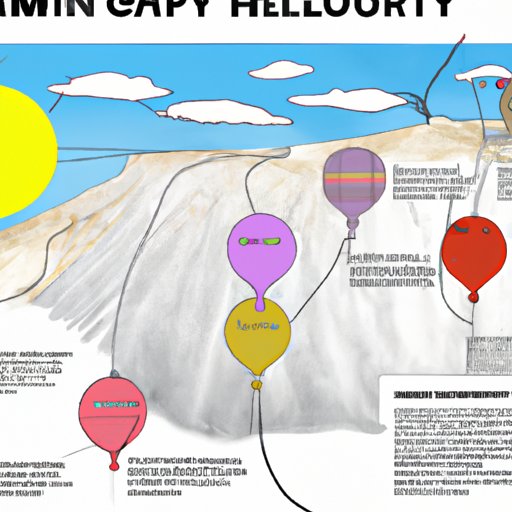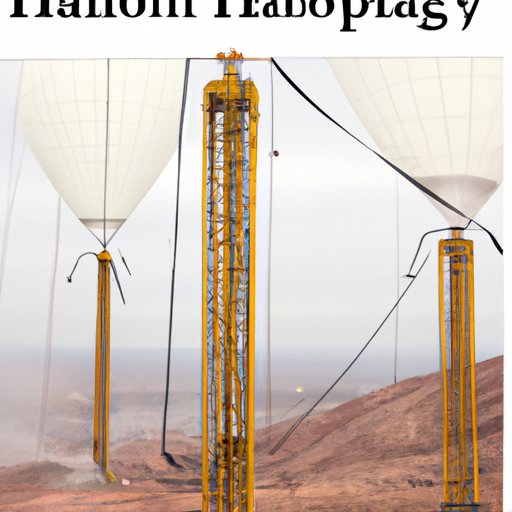Introduction
Mining for helium is a complex process that involves extracting the element from the earth. The purpose of this article is to explore how helium mining works and examine the various aspects of the process. From the science behind it to the equipment used to the environmental impacts, this comprehensive guide will provide an in-depth look at the world of helium mining.

Exploring the Science of Helium Mining
Before delving into the specifics of helium mining, let’s first take a look at the science behind it. What is helium? And why is it so important?
What is Helium?
Helium is a colorless, odorless, tasteless noble gas that is the second most abundant element in the universe after hydrogen. It is non-toxic and non-flammable, making it a safe and versatile resource for many applications.
Properties of Helium
Helium has several unique properties that make it useful in many industries. It is extremely light, which makes it ideal for use in balloons, blimps, and other lighter-than-air applications. It is also an excellent insulator, both thermally and electrically, making it invaluable for cryogenics and superconductivity. Finally, it is highly unreactive, meaning it can be used in welding and other high-heat applications without fear of combustion.
Where is Helium Found?
Helium is found in natural gas deposits deep underground. It is released from the ground as a result of radioactive decay, and is typically present in concentrations of 0.1% – 0.2%. As such, it is not practical to extract helium from air, as the concentration is too low to make it cost effective.
What is Involved in Mining for Helium?
Mining for helium is a complex process that involves a number of steps. Let’s take a look at what is involved in mining for this valuable resource.
Different Types of Helium Mining
There are two main types of helium mining: conventional mining and unconventional mining. Conventional mining involves extracting helium from natural gas deposits through a process called fractional distillation. Unconventional mining, on the other hand, involves extracting helium from underground reservoirs, often using specialized equipment such as pumps and compressors.
Challenges of Mining for Helium
Mining for helium is a difficult and expensive endeavor. Because the gas is so light, it can be difficult to capture and store. Additionally, the environment in which it is found can be physically hostile, with extreme temperatures and pressure. Finally, the resources used in the mining process can be expensive, making it a costly undertaking.
Examining the Processes and Equipment Used in Helium Mining
Now that we have a better understanding of the challenges associated with helium mining, let’s take a look at the actual processes and equipment used in the endeavor.
The Drilling Process
Drilling is the first step in any helium mining operation. The drill bit is inserted into the ground to reach the natural gas deposit. Once the bit reaches the desired depth, a mixture of water, nitrogen, and carbon dioxide is pumped down the hole to fracture the rock and release the gas. This process is repeated until the desired amount of helium is extracted.
Other Equipment Used
In addition to the drilling rig, there are a number of other pieces of equipment used in helium mining. These include pumps, compressors, and tanks for storing the extracted gas. Depending on the size and scope of the mining operation, additional equipment may be required as well.

A Look at Helium Mining Operations Around the World
Helium mining is a global industry, with operations in many countries around the world. Let’s take a look at some of the major helium mining sites and the regulations surrounding them.
Major Helium Mining Sites
The United States is the largest producer of helium, accounting for more than 75% of global production. Other major producers include Qatar, Algeria, Russia, and Poland. In addition, China and India are both emerging players in the helium mining industry.
Regulations Surrounding Helium Mining
As with any mining activity, there are regulations in place to ensure safety and protect the environment. These regulations vary depending on the country in which the mining operation is taking place. Generally, they include requirements for proper storage and handling of the gas, as well as limits on the amount of emissions allowed.
How the Price of Helium Impacts Mining Operations
The price of helium is an important factor in determining the viability of a mining operation. Let’s take a look at how the price of helium affects the industry.
Factors Affecting the Price of Helium
The price of helium is affected by a number of factors, including supply and demand, geopolitical issues, and technological advances. For example, if demand for helium increases, the price may go up, whereas if new technologies are developed to make mining more efficient, the price may go down.
Impact on Mining Operations
The price of helium has a direct impact on mining operations. If the price is too low, it may not be profitable to mine for the gas, leading to decreased production and fewer jobs in the industry. On the other hand, if the price is high enough, it can be a lucrative endeavor, leading to increased production and job growth.

The Environmental Impact of Helium Mining
The environmental impact of helium mining is an important consideration. Let’s take a look at some of the potential impacts of this activity.
Air and Water Pollution
Mining for helium can result in air and water pollution due to the release of toxic gases and chemicals. According to a study by the University of Texas, “Helium mining operations release significant amounts of pollutants into the atmosphere, including sulfur dioxide, nitrogen oxide, and particulates.”
Toxic Waste Disposal
Another environmental concern related to helium mining is the disposal of toxic waste. Many of the chemicals used in the mining process can be hazardous to human health and the environment if not properly disposed of. As such, it is important for mining operations to have stringent protocols in place for the safe disposal of these materials.
Conclusion
This article has explored the science and processes behind helium mining operations around the world. We looked at the properties of helium, different types of mining, equipment used, global regulations, and the environmental impact of this activity. Mining for helium is a complex process that requires specialized knowledge and equipment. It is also subject to a variety of regulations and can have a significant environmental impact. As such, it is important to understand the intricacies of this process before embarking on a mining venture.
Summary of Main Points
This article provided a comprehensive overview of helium mining. We discussed the science behind the element, the different types of mining, the equipment used, the regulations in place, the impact of the price of helium, and the environmental considerations. All of these aspects should be taken into account when planning a mining operation.
Final Thoughts on Helium Mining
Helium mining is a complex and potentially risky endeavor. However, if done correctly, it can be a lucrative and rewarding experience. By understanding the science, process, and regulations involved, miners can ensure the success of their operations while minimizing the potential risks.
(Note: Is this article not meeting your expectations? Do you have knowledge or insights to share? Unlock new opportunities and expand your reach by joining our authors team. Click Registration to join us and share your expertise with our readers.)
